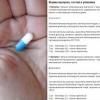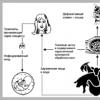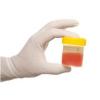Chancre on the tongue looks like. Syphilis of the oral cavity. Atypical lesions of the tongue in syphilis
Unlike most sexually transmitted diseases, syphilis can be contracted not only through sexual contact. Quite a few cases are associated with infection in the oral cavity. For timely diagnosis and treatment, you need to know what the tongue looks like with syphilis.
The oral cavity and tongue in particular can be attacked by the causative agent of syphilis - pale treponema. This anaerobe has the shape of a spiral, which allows it to penetrate into the intercellular space without any problems.
The following factors can become the causes of infection with this dangerous disease:
| Name and photo | Short description |
| Kiss
| The saliva of a sick person may contain treponemas that penetrate the mucous membrane of the mouth of a healthy partner, especially if there are wounds and microcracks in the oral cavity. |
| oral sex
| The causative agent of syphilis can be on the surface of the genital organs or secretions, in particular, semen. Unprotected oral sex is a direct route to infection. |
| Use of non-sterile medical instruments
| This is especially true for dental offices. The doctor must use sterile instruments for each patient. |
| Using other people's items, in particular those intended for personal hygiene
| The infection can be transmitted through a toothbrush, dishes, cigarettes and other personal items. |
| Close contact with an infected person in an unsafe phase
| This variant of the spread of the disease is very rare, because when sneezing or coughing, shaking hands, infection of others rarely occurs, but the contact path is not completely excluded. |
| Blood transfusion
| Syphilis easily enters the human body if infected blood was used in a transfusion. |
| Intrauterine transmission of infection
| A child is born with a congenital form of the disease, which may manifest itself immediately or during subsequent years of life. |
| Breast-feeding
| Treponemas can enter the mouth of an infant with breast milk or from the surface of the skin if there are active manifestations of the disease on the chest. |
Stages and symptoms
The way syphilis looks on the tongue depends largely on the stage at which the disease is located. In total, 3 active phases of the course of the disease and the incubation period preceding them are distinguished. The features of the manifestation of each stage should be analyzed in more detail.
Incubation period
From the moment Treponema pallidum enters the human body, it often takes about 3-4 weeks before the disease reveals itself. This entire period is usually referred to as the incubation period.
The late response is due to several factors:
- immune response. Towards the causative agent of syphilis, the body sends antibodies, lymphocytes and macrophages. In rare cases, it is possible to completely stop the infection. But more often than not, immunity does not cope with the invasion.
- Slow multiplication of treponemas. The division of this microbe takes about 32 hours, and to activate the disease, it is necessary to reach a certain number.
- General health. Weakened by chronic diseases, alcohol, HIV infection, the body will quickly surrender to the causative agent of syphilis.
Each person has a different incubation period. In some, the disease begins to act almost immediately, in others it may take several months before the first suspicions of infection arise.

Primary
When the primary phase comes, pale treponema becomes already enough for a person to notice health problems. At this stage, which can last several months, a characteristic sign of syphilis appears on the tongue (or on another part of the body - the genitals, in the oral cavity, etc.) - a hard chancre.
Its edges have a dense structure and clear contours, the color of the formation is predominantly red with a bluish tint. Erosion forms in the center, the bottom of which is hard to the touch, and the color varies from bright red to brown.

Sometimes a white coating may form on the surface of the chancre, which, when removed, exposes the ulcer. With the formation of a chancre in the folds of the tongue, another problem arises - crevice erosion.
The following symptoms may also appear:
- weakness;
- a slight increase in temperature;
- an increase in regional lymph nodes;
- pain is most often absent or very mild.
Secondary
For the secondary phase of syphilis, a characteristic feature is the appearance of external signs not only in the area through which the infection occurred, but also throughout the body. So, some patients have a syphilitic rash. At this time, a person is especially contagious to others.


Language with secondary syphilis is as follows:
- the chancre disappears, no traces remain in its place;
- papules and roseola form on the surface of the tongue;
- the color of the foci of manifestation of infection can be pinkish-bluish, red, with a grayish coating;
- the papillae of the tongue are smoothed out, these areas stand out with a glossy sheen;
- the temperature is kept at subfebrile levels;
- spots can spread beyond the tongue, affecting the lips, tonsils;
- pain when eating and swallowing is absent.
Such symptoms clearly indicate a problem, but a person does not always adequately assess the situation. Some of the signs can be perceived as manifestations of stomatitis, glossitis, tonsillitis or other relatively harmless diseases of the oral cavity. At the same time, an unsuspecting patient can easily infect his loved ones with syphilis.
The total duration of the secondary stage is usually several years. During this time, the spots may temporarily disappear and then reappear.
Tertiary
The last phase is tertiary syphilis. Here, changes are found in the structure of the tissues of the affected organ, the disease spreads to other body systems. This stage is characterized by alternating periods of exacerbation and remission. Frequent stress, exacerbations of chronic diseases, and even the common cold can provoke the manifestation of the disease.
With syphilis, the tongue begins to become covered with gums, which are considered relatively safe for the surrounding formations, since they do not contain pale treponemas. However, they can provoke the formation of infiltrates and nodular inclusions.
As a result, glossitis develops, which changes the structure of the tissues of the tongue, provoking its ulceration and coarsening. As a result, the body loses its mobility, it becomes difficult for a person to speak. In addition, ulcers cause severe discomfort and can provoke malignant processes in tissues.

Diagnostics
Very often, the manifestations of syphilis in the tongue are perceived by the patient as a symptom of another disease. This complicates the situation, as precious time is wasted.
To detect syphilis, the following methods are used:
- ELISA;
- Wasserman reaction;
- PCR;
- RIBT;
- REEF.
The instruction for qualitative diagnostics involves the use of several research methods at the same time. This will increase the chances of early detection of the problem and eliminate false positive results.
For example, the Wasserman reaction may erroneously indicate the presence of an infection in such cases:
- pregnancy;
- menstruation;
- tuberculosis;
- malaria;
- diseases of the hematopoietic system;
- recent introduction of anesthesia.
The requirement for differential diagnosis cannot be ignored. The doctor is obliged to conduct it in relation to such diseases:
- stomatitis;
- glossitis;
- angina;
- oral candidiasis;
- mechanical injury.
When confirming the diagnosis of syphilis, it is necessary to regularly take tests during treatment so as not to lose control of the situation.
Treatment Methods
Special drugs are needed to treat syphilis. Mostly antibiotics of the penicillin group and their derivatives are used. Some patients may experience an allergic reaction to their use or poor efficacy.
In such cases, they resort to the use of tetracyclines, bismuth preparations, aminoglycosides, etc. Additionally, rinsing the mouth with solutions of boric acid and furacilin is prescribed.
To compensate for the action of antibiotics, it is recommended to take vitamins and complexes with prebiotics to strengthen the body. This will help to avoid the development of dysbacteriosis and restore the beneficial microflora of the body.
In order to avoid risks, additional treatment is carried out for all people who have been in close contact with the patient and could become infected with syphilis.
Consequences and prognosis
With timely admission to the hospital, the prognosis is quite favorable. Today, syphilis of the tongue can be cured with the help of available medicines. The price of some of them is quite low.
It is important to have time to start therapy before the treponemas disperse throughout the body and begin to destroy the internal organs of the patient. Otherwise, complications cannot be avoided, and in the absence of high-quality treatment, a lethal outcome is not ruled out.
With syphilis of the tongue, the following complications are possible:
- nodular and diffuse glossitis;
- joining the infection;
- scarring of oral tissues;
- violation of speech function;
- damage to internal organs and the nervous system;
- oncology;
- fatal outcome.
Primary and secondary syphilis can often be cured without serious consequences. In the tertiary form, gum scars on the surface of the tongue are inevitably preserved.
In order to ensure the success of therapy, the patient remains registered for several more years. During this time, you need to regularly take control tests, since treponemas can remain in the body in the form of cysts, waiting for favorable conditions for their awakening. If the tests consistently show negative results, we can talk about a complete recovery.
Prevention
To prevent syphilis of the tongue, you must follow a few fairly simple rules:
- give up promiscuity;
- use a condom to protect against sexually transmitted diseases;
- do not use other people's things;
- monitor the sterility of medical instruments;
- take tests for syphilis during a routine medical examination;
- if suspicious signs are detected, immediately contact a venereologist;
- do not start uncontrolled antibiotics, so as not to provoke the transition of the disease into a latent form;
- strengthen your immunity.
If syphilis has already been detected, it is necessary to limit contact with people until the infection is stopped. It is also important that people who could potentially become infected receive preventive examinations and appropriate therapy. You can get more information on the topic from the video in this article.
- a chronic infectious disease caused by pale treponema. With a primary lesion, a hard chancre is formed on the mucosa - an infiltrate with a decay site in the red center of a regular rounded shape. There are no complaints of pain. Secondary syphilis of the oral cavity is characterized by the occurrence of a multiple rash of a roseolous-papular nature. The presence of gummous infiltrate indicates tertiary syphilis of the oral cavity. Diagnosis of the disease includes a clinical examination, bacterioscopy of scrapings, serological reactions, radiography. Treatment of syphilis of the oral cavity is carried out in a dermatovenerological dispensary.

General information
Syphilis of the oral cavity is a specific infectious disease resulting from the penetration of pale treponema into the body. In most patients diagnosed with syphilis, characteristic signs of damage to the oral mucosa, periosteum, or bone tissue of the upper and lower jaws are revealed. Often it is in the oral cavity that primary syphilitic foci are localized. In primary oral syphilis, 1 chancre is found in 95% of patients. It is extremely rare for several syphilomas to form. During the tertiary period, gummous infiltrates that destroy bone tissue are more often detected in the lower jaw. In children and adolescents, the main routes of infection are intrauterine and household, while in older people, in most cases, infection with oral syphilis occurs due to unprotected intercourse.

Causes and classification of oral syphilis
Syphilis of the oral cavity develops as a result of infection with pale treponema. The main ways of transmission of the disease are intrauterine, domestic, sexual. Predisposing conditions that open the gate for the introduction of anaerobes are skin cracks, erosion of the oral mucosa. At the site of introduction of spirochetes, a hard chancre is formed. The reproduction of bacteria in oral syphilis occurs in the lymph nodes, as a result of which polyadenitis is observed already a few days after infection. In response to the penetration of pale treponema into the body, the human immune system produces antibodies aimed at binding and eliminating infectious agents. Further spread of bacteria in the human body is carried out through the vessels of the lymphatic system.
Oral syphilis goes through 4 periods:
1. Incubation. It is characterized by the absence of a specific clinic, lasts for 3-5 weeks from the moment of infection.
2. Primary oral syphilis. Occurs with the appearance of primary syphiloma in the oral cavity, proceeds for 6-8 weeks. The first 3 weeks are seronegative, as specific serological tests fail to isolate treponema pallidum. The next 3 weeks are referred to as the seropositive period.
3. Secondary oral syphilis. Observed for 4 years. Mucous membranes, skin, internal organs are affected. Secondary syphilis of the oral cavity begins with a phase of pronounced clinical manifestations lasting about 3 weeks. At the same time, multiple foci of roseolous-papular rash appear on the oral mucosa, polyadenitis is observed. Further, the disease passes into the latent stage. Alternating exacerbations and remissions can occur up to 3-4 times. Serological reactions are positive.
4. Tertiary oral syphilis. Lasts for 6-8 years. The main element of the lesion is a gummous infiltrate. The number of pale treponemas is significantly reduced. Serological reactions are positive in 70% of cases. Tertiary syphilis leads to irreversible destructive changes in organs and systems, causing progressive paralysis.
Symptoms of oral syphilis
The clinic of the disease directly depends on the stage of the course of the pathological process. Primary syphilis of the oral cavity is indicated by the appearance of an infiltrate, in the center of which a decay zone is formed. The edges of the primary element of the lesion are regular, even, the bottom is red, infiltrated. On examination, the syphiloma is painless, slightly elevated above the mucosa. Due to the activation of anaerobic microflora, the bottom of the ulcer is covered with a dark gray coating. More often, hard chancre is localized on the lips, tongue, palate, tonsils. A few days after the appearance of syphiloma, lymphadenitis is observed, accompanied by hyperthermia, lethargy, deterioration in the general condition.
Secondary syphilis of the oral cavity is characterized by the occurrence of syphilitic tonsillitis and multiple roseolous-papular elements of the lesion. Roseola are hyperemic areas of the mucosa with clear contours. Papules are foci of mucosal changes in color (usually bluish-red) with a slight elevation in the center. The favorite localization of morphological elements in secondary syphilis of the oral cavity is the distal areas (palate, tonsils). Papules and roseola tend to merge, resulting in a clinic that resembles a sore throat. Syphilitic lesion of the tongue manifests itself in the form of atrophy of the filiform and trough papillae. At the same time, the back of the tongue takes on the appearance of a “sloping meadow” - normal areas of the mucous membrane alternate with pathologically altered zones.
With tertiary syphilis of the oral cavity, a gummous infiltrate is formed. The pathological process can affect the tongue, which leads to its thickening, scarring, and permanent deformation. When the periosteum is involved in the inflammatory process, a periosteal seal occurs, soldering with the mucosa. In the case of localization of a syphilitic lesion in the area of the alveolar process, pathological mobility of the teeth is observed, the vertical percussion of which becomes positive. When the infiltrate breaks through, a painless ulcerative surface of a crater-like shape with smooth edges is formed. The formation and rejection of sequesters in oral syphilis is rare. Over time, the affected area scars. As a result of the formation of gumma on the upper jaw, an anastomosis of the oral cavity with the nasal cavity may occur. With tertiary syphilis of the oral cavity, the integrity of the bones of the nose, the nasal septum is violated.
Diagnosis of oral syphilis
The diagnosis of "syphilis of the oral cavity" is based on the patient's complaints, the history of the disease, clinical examination, and the results of additional research methods. With primary syphilis of the oral cavity, the dentist usually reveals one hard chancre. On palpation, the resulting ulcerative surface is painless, regular, rounded, red in color with even raised edges and an infiltrated sebaceous bottom. Lymph nodes are compacted, enlarged, painless, not soldered to the skin and surrounding tissues. With secondary syphilis of the oral cavity, residual syphilomas are found, as well as a roseolous-papular rash on the palate, arches, and tonsils. Scraping papules leads to exposure of erosive surfaces. In the case of recurrence of secondary syphilis of the oral cavity, less rash elements are formed, papules and roseola are pale in color, grouped, forming figures resembling garlands in shape, lace.
With secondary syphilis of the oral cavity, polyadenitis is detected. Unlike catarrhal angina, pain when swallowing and a high temperature reaction are not observed with syphilitic lesions. In tertiary syphilis of the oral cavity, a gummous infiltrate is detected, after the collapse of which a deep crater-like ulcerative surface is formed. Violated the integrity of the jaws, bones of the nose. The affected areas are scarred, which leads to persistent deformities. There is no enlargement of regional lymph nodes. Detection of pale treponema in a scraping or in the contents of the lymph nodes confirms the diagnosis of oral syphilis. To detect syphilitic lesions, serological reactions are also used, which in patients become persistently positive, starting from 4 weeks from the moment of formation of a hard chancre. The first 3 weeks of the course of primary oral syphilis are a seronegative period, since at this time it is not possible to confirm the diagnosis using serological reactions.
Radiographically, in patients with tertiary syphilis of the oral cavity, zones of rarefaction of bone tissue are diagnosed in areas corresponding to gummous lesions, as well as sclerotic changes along the periphery. There is destruction of the cortical layer of the bone, signs of ossifying periostitis. Oral syphilis is differentiated from a decubital ulcer, a malignant tumor, tuberculous and actinomycotic lesions, tonsillitis, chancriform pyoderma, Setton's aphthae, lichen planus, leukoplakia. The patient is examined by a dentist-therapist or a dental surgeon. If a specific syphilitic infection is suspected, the patient is referred for a consultation to the dermatovenerological department.
Treatment of oral syphilis
Oral syphilis is treated in a specialized venereal dispensary. Washing of syphilitic lesions with antiseptics is indicated locally. For this purpose, chloramine-based products are more often used in dentistry. Bulging granulations are cauterized with solutions of chromic acid. If signs of pulp non-viability are detected, endodontic treatment is carried out in accordance with the principles of chronic periodontitis therapy. In most cases, after filling the canals, the mobility of the teeth decreases.
In the phase of severe symptoms, surgical intervention aimed at removing the formed sequesters is not performed. Sequestrectomy for oral syphilis is indicated only after the clinical manifestations of the disease have subsided. In the period of remission, sanitizing measures are carried out, consisting in the removal of dental plaque, the treatment of caries and its complications. With early treatment, full-fledged complex treatment, the prognosis for oral syphilis is favorable. After recovery and deregistration, the resulting defects are subject to surgical plastic surgery.
To date, syphilis in the mouth is a fairly common problem among young people and not only. Many refuse healthy sexual contact, regular medical examination. Sometimes syphilis of the oral mucosa appears after using infected items - toothpicks, spoons, forks, toothbrushes.
Please note that the disease can be cured only at an early stage after timely diagnosis. How dangerous is an infectious disease? How to prevent it?
After pale treponema is in the mouth, the person becomes ill. First, it affects the mucous membrane, after a while it gets to the jaw, bone tissue. Depending on the location, the symptoms determine the presence of primary or secondary syphilis in the oral cavity.
The primary form is characterized by the appearance of one large hard chancre. In severe cases, many syphilomas appear. The tertiary period is dangerous, in which gummy infiltrates appear, they eventually destroy the bone of the lower jaw. Children and adolescents are infected in utero or in the household. Older people contract the infection during unprotected sex.
Those who have in their mouths are at risk of getting sick:
- erosion of the mucosa;
- Cracks in the skin.
Syphilis is dangerous because bacteria can begin to multiply in the lymph nodes, subsequently polyadenitis develops. It is important to prevent microorganisms from entering the vessels of the lymphatic system, otherwise they will end up in the body.
There are such factors of infection with syphilis:
- Visit to the doctor. For example, to the ENT, dentist. Treponema enters the cavity after using an infected medical instrument. Sometimes the bacterium is in the blood if the medical staff illiterately performs the operation, makes an injection, uses an unsterile scalpel, syringe.
- Constant contact with patients. Every day, gynecologists and venereologists risk getting sick, so they need to be careful.
- A pregnant woman is sick with syphilis, treponema is transmitted to the unborn child in utero. Many doctors give permission for natural childbirth, do not treat a woman, and subsequently the baby is born with syphilis in her mouth. The baby becomes infected through the mother's blood.
- Injury to the oral mucosa. Dangerous are ulcers, microcracks, wounds in the mouth, as well as bleeding gums - this is an ideal environment for the reproduction of treponema.
- Oral sex with a sick person, as well as ordinary kissing, can lead to infection.
- Increased humidity. If a person accidentally uses a cup, other household items after the patient, he becomes infected with syphilis.
Symptoms
The phases of the development of the disease affect the manifestations of syphilis in the oral cavity.
The first stage - the appearance of the chancre
What does syphilis look like in the mouth? After the pathogen enters the mucosa, a hard, round ulcer can be seen, it does not cause pain to the patient. Chancre appears anywhere - on the tonsils, palate, tongue, gums, inside of the cheek. Pay attention to syphilis in the mouth photo. Sometimes there is not one ulcer, but several at once. For example, in the language, the chancre looks like a furrow. The patient feels a certain seal, while nearby lymph nodes are greatly enlarged.

The second stage - stomatitis, the appearance of papules
At this stage, the chancre disappears, but rashes appear on the body, mucous membrane. After a few days, red roseola can be seen in the mouth, they merge, then begin to increase. Subsequently, diffuse acute stomatitis develops.
Rarely does a person immediately notice roseolas because they do not bother him. Most often, the palate, tongue, and inner lip edging are covered with spots. It is inside roseola that the pathogen is concentrated. It is important at this stage to start taking antibacterial drugs, otherwise a relapse cannot be avoided. The spots will disappear, then reappear, forming plaques, papules.
How to distinguish roseola and papules? The last formations are asymmetrical. After trying to remove the top layer, peeling occurs. It is especially unpleasant when papules affect the tongue, after a while the sensitivity of the organ is lost.
In some patients, syphilis of the oral cavity is characterized by purulent abscesses, while the lymph nodes throughout the body sharply increase, the temperature rises. The second stage of syphilis is especially dangerous, a person can infect others, because these formations contain a large amount of treponema.
A patient with an infection should be isolated from the environment and taken to a hospital. If at this stage you do not start taking a course of therapy, the treponema will end up in the pharynx, larynx, everything will end with syphilis of the throat.
The third stage - glossitis, the formation of gum
This is the advanced phase of syphilis in the mouth. It manifests itself in the form of the appearance of nodules, bumps, abscesses. Patients have to suffer for about six months. First, the tongue and palate thicken, then immediately large ulcers appear. After the wound heals completely, a scar forms, it leads to deformation of the tissues and bones of the jaw.
It is difficult for the patient to speak articulately. With syphilis of the mouth, a diffuse form of glossitis develops, in which the connective tissue is affected. It is painful for a person to swallow food, he cannot communicate normally.
Diagnostics
First of all, the infectious disease specialist is interested in the history of the disease. If a person has had syphilis at least once, after a while the infection again makes itself felt. In addition, the doctor carefully examines the patient, he is interested in the manifestation of oral syphilis. Most alarming are mouth ulcers with syphilis. After the specialist appoints a serological study. If pale treponema is not found in the hard chancre, it is found in the contents of the lymph nodes.

On a note! When diagnosing, the doctor differentiates syphilis and catarrhal tonsillitis. The symptoms vary greatly. With angina, pain occurs when swallowing, the temperature rises.
Pronounced tertiary oral syphilis. The infection may manifest as a gummy infiltrate with an ulcerative surface. With the help of scraping, serological reaction, pale treponema is detected.
Of no small importance is the x-ray, which shows the affected areas. This diagnostic method allows you to distinguish the infection from tonsillitis, tuberculous lesions, Setton's aphthae, leukoplakia, pyoderma. First, the patient is examined by a dentist, paying attention to the signs of syphilis. Then the patient is sent to the venereology department.
Treatment Methods
The patient is undergoing therapy in the venereological department of the hospital. All affected areas must be washed with special antiseptics, which contain Chloramine. Also, for the treatment of the mucosa, if the ulcers bleed heavily, the doctor prescribes a mercury white ointment. Facilitate the condition of the powder - Calomel, Xeroform. To get rid of various hypertrophic growths, a solution of chromic acid, 10% lapis, is used.
When the symptoms are pronounced, any operation is prohibited. Sequestrectomy is performed only after the patient feels better. At the same time, all dental deposits are removed, caries is treated. If you consult a doctor in a timely manner, the prognosis will be very favorable. After the patient fully recovers, surgical plastic is performed to eliminate all defects.
What happens if you do not treat syphilis in the mouth
Each patient must understand that the infection is quite dangerous, over time such unpleasant complications arise:
- local bleeding;
- The brain is slowly being destroyed;
- Internal organs, bones are affected;
- The circulatory and vascular systems do not work properly;
- Necrosis develops;
- The contours of the face become asymmetrical.
Treatment of syphilis of the oral mucosa in the second and third stages is a complex and lengthy process.
To prevent a dangerous disease, it is important to follow these simple rules:
- Visit the dentist regularly;
- Take tests;
- Carefully examine the oral cavity;
- Avoid promiscuous sexual intercourse;
- Strengthen immunity.

Let's summarize! Syphilis affecting the oral cavity is a dangerous disease. Symptoms may appear too late, when it is no longer possible to completely get rid of the infection. Remember preventive measures. It is easier to prevent an illness than to treat it. Be healthy!
A syphilitic infection in the mouth brings a lot of inconvenience. This article describes the basics of the disease, its classification, etiology, diagnosis, treatment of oral syphilis and prevention.
Fundamentals of Pathology
Oral syphilis is a type of sexually transmitted disease. Pathology is caused by a pale spirochete, localized on the oral mucosa. The first signs are visualized in this part of the body.
According to the International Classification of Diseases by etiology, syphilis is classified into:
- Congenital
- Acquired
Important! Syphilis in the mouth can be treated only at the initial stage of the development of pathology. If left untreated, the infection spreads rapidly with the flow of blood and lymph to all organs and tissues.
Causes of syphilis in the mouth

Pale treponema - the causative agent of syphilis
There is congenital and acquired syphilis. The first occurs when a pathogen enters the fetus through the placenta from an infected mother. The second develops when pale treponema infects a person, penetrating through injured mucous membranes, skin, during intercourse.
Experts pay attention to factors that contribute to causing syphilis in the mouth:
- The use of non-sterile medical instruments in dentistry, ENT practice.
- Entering the pathogen into the bloodstream during blood transfusion, during injections, during surgical intervention.
- Using the same household items (cutlery, toothbrush, bath accessories).
- Oral sex.
There are circumstances that increase the risk of infection. These include:
- Injuries of the oral mucosa.
- Unhealthy lifestyle.
- Weak general and local immunity.
Ways of infection
The development of syphilis in the mouth provides for the following ways of infection:
- intrauterine When a pregnant woman with syphilis has not received a therapeutic course, there is a risk of infection of the fetus. It depends on the degree of the disease, and then the child can be born with congenital syphilis, with deformities, with pathologies leading to death, and maybe healthy.
- Domestic the path of infection occurs when the elementary rules of personal hygiene are ignored, the use of household items and medical instruments contaminated with syphilis pathogens that are not disinfected and not washed in the proper way.
- Sexual The route of infection with oral syphilis comes from an infected healthy partner at the time of oral sex and kissing.

Intrauterine infection with syphilis
Pale treponema penetrates into the human body due to abrasions, scratches of the epidermis and mucous membranes, as well as through the blood. Having penetrated into the body, the spirochete is localized in the tissue base. The incubation stage lasts from two weeks to six months. During this period, the microbe penetrated the mucous membrane, but does not yet cause the degree of damage that would have a clinical picture.
Congenital syphilis in the mouth may result from intrauterine transmission of triponema. During delivery of an infected woman who has not completed the appropriate therapeutic course, the child is born with signs of syphilis in the oral cavity.
Symptoms and stages (+ photo)
The formation of syphiloma is possible in any area of the oral cavity. Often, a solid formation that appears in the gum area or on the mucous membrane of the lips is of concern. It is painless, but causes discomfort during chewing, articulatory movements and does not look aesthetically pleasing. The size of the rash is from 0.1 to 2.0 cm. Their location can be single or group.
External signs of syphilis in the mouth are characterized by visual manifestations, each of which is characteristic of the stage of the disease.
| Stage | Symptoms |
| In the mouth, at the site of the affected mucosa, a round-shaped ulcer of a solid consistency is observed. Characterized by the absence of pain. A single ulcer may form, or several at once in different parts of the oral cavity. The main localization of the chancre is the tonsils, tongue, periodontal tissue and the inner region of the cheeks. |
| Characterized by the disappearance of the chancre. The mucous membrane of the oral cavity is covered with rashes. With the progression of the pathology, they develop into red roseolas, which, with the progression of the pathology, begin to merge and rapidly increase in size. The main place of localization is the sky, the edging of the lips inside the mouth, the tongue. The appearance of purulent abscesses and papules is possible. |
| On the affected areas of the oral cavity, nodules, tubercles and abscesses are observed. At the initial stage, seals form on the tongue, which in the shortest possible time are converted into large ulcers. Gummas are often located singly. It is small in size, no more than 1.5 cm in diameter. Subsequently, it opens and transforms into an abscess, accompanied by pain. |
Signs of various types of syphilis in the oral cavity
In medical practice, depending on the stage of development of the pathology, there are:
- Primary syphilis in the mouth is manifested by a hard ulcerative formation, the so-called hard chancre. In the initial stage of the disease, there is an increase in the cervical, submandibular and occipital lymph nodes. This period lasts from six to eight weeks. But even in the presence of the first symptoms of syphilis, it is not possible to determine the causative agent of the disease in the laboratory. In such cases, a blood test for a polymerase chain reaction is prescribed.
- Secondary syphilis in the mouth is characterized by the appearance of rashes of various types and more vivid symptoms. After the end of the course of the second phase of the disease, remission occurs, which can periodically be interrupted by an exacerbation of the pathology. This action can occur up to ten times. The duration of the period reaches an average of five years.
- Tertiary syphilis in the mouth is the last stage of the disease, manifested by irreversible damage to the organs of various body systems. The central nervous system suffers especially in the form of paresis, cerebral disorders, dementia and other pathologies.
Diagnostics

For diagnosis, contact a dermatovenereologist.
At the manifestation of the slightest signs of pathology, it is necessary to immediately seek qualified medical help. The treatment of syphilis in the oral cavity is primarily a dermatovenereologist.
To diagnose syphilis in the oral cavity, experts recommend undergoing a series of examinations. First of all they are:
- Examining patient complaints
- Conduct a thorough visual inspection
- Blood is sent for laboratory testing for:
- classic serological reaction
- RV (Wasserman district)
- RIF (immunofluorescence reaction).
- RPHA (passive hemagglutination reaction)
The presence of syphilis is confirmed by the detection of a pathogen of the disease in the area of the primary sore or in the contents of closely spaced lymph nodes. If we get a negative result, it is necessary to repeat the study of the exudate of the hard chancre for the presence of a pale spirochete, since its presence is the main one in the diagnostic measures for syphilis of the first phase of development.
Serological laboratory examination will be a little later, 21 days after the formation of a hard chancre. From day 22, all serological reactions acquire a stable positive response. Therefore, the primary stage of syphilis is divided into primary seronegative, when the Wasserman reaction, sedimentary reactions are negative, and primary seropositive, which occurs 21-28 days after the formation of a hard chancre.
At this time, the tests performed by the serological method have positive results and are observed for a long time.
Important! Depending on the etiology of the disease, as well as to differentiate syphilis from other pathologies, additional examinations may be prescribed. Most often, this is an x-ray, a puncture of fluid from the spinal cord.
Treatment

In no case do not self-medicate!
The main objective of the therapeutic course is the elimination of pale treponema from the body, relief of symptoms and prevention of pathology. Treatment is carried out exclusively in the conditions of the venereological department of specialized medical institutions.
The treatment course consists of:
- Local therapy, which consists in washing syphilitic lesions with antiseptic preparations. Most often, the main active ingredient in such antiseptics is chloramine. When bleeding ulcers are treated with mercury white ointment. Calomel or xeroform powders are effective symptomatic. To stop the process of growth of hypertrophic ulcers will help a solution of chromic acid or 10% lapis.
- Antibacterial therapy. Long-term antibiotics are prescribed. The most common is a long course of injections of penicillin. With intolerance to penicillin, tablet antibiotics of various groups are taken.
- Reception of immunomodulators helps to strengthen the protective functions of the body.
- Symptomatic treatment is selected taking into account the stage of development of syphilis and accompanying signs. For this, antipyretics, painkillers, antihistamines, agents to stimulate tissue regeneration are prescribed.
- Sequestrectomy carried out under the condition of complete subsidence of the clinic of the disease.
Important! Secondary and tertiary forms of syphilis are practically not amenable to therapy. Regular examination for this pathology will allow timely detection of the disease and its effective treatment.
The prognosis for recovery after diagnosing syphilis in the mouth can be positive, provided that the pathology is detected and treated promptly. In the treatment of this disease, it is important to complete a full course and not take a temporary reduction in symptoms for recovery.
Possible Complications
Complications of syphilis in the mouth often develop with untimely treatment and diagnostic examination. In this connection, the pathogenic effect of spirochetes extends, in addition to tissues in the oral cavity, to systemic organs inside the body.

A good example of a complication of syphilis in the mouth.
As a result, various complications arise, manifested:
- Damage to the skeletal system and organs.
- Necrosis of the muscular skeleton at the site of the lesion.
- Bleeding of a local nature.
- Dysfunctions of the circulatory system.
- Asymmetry of the face with lesions of the facial and cervical muscles.
- Destruction of the cellular structure of the brain.
It is important not to delay visiting a venereal clinic in order to prevent the development of severe consequences of an insidious disease. And it must be remembered that immunity to this venous disease is not formed, and therefore, if any rashes appear on the mucous membrane of the cheeks, gums, tongue, you should seek medical advice from specialists.
Preventive measures
Prevention of sexually transmitted syphilis is based on the following activities:
- Systematic examination for syphilis, especially with active sexual life.
- Exclusion of casual sexual relations with little-known partners.
- Mandatory use of barrier contraceptives, especially during oral sex.
Household syphilis can be prevented by observing the following preventive measures:
- Strict observance of the rules of personal hygiene.
- Exclusion of physical contact with an infected person.
- When living together with a sick person, there should be strictly individual dishes, personal hygiene items, clothes and bedding.
- Systematic disinfection of bathroom items.
Reference! The passage of preventive therapy is assigned to family members who have a sick person.
Prevention of congenital syphilis is:
- Preliminary examination for syphilis at the preparatory stage for pregnancy.
- Throughout pregnancy, undergo routine examinations for syphilis RPGA.
- If the results are positive, the woman must undergo mandatory treatment.
- Undergoing prophylactic treatment, provided that the woman had previously had syphilis.
Within 2 days after sexual contact with a possibly infected person, an emergency syphilis prophylaxis can be obtained from a venereologist.
Popular questions

The penetration of pale treponema into the body, provoking the development of syphilis, through the oral cavity is possible with kisses and oral sex.
It is worth noting that the causative agent of syphilis penetrates into saliva even despite the integrity of the oral mucosa. With the penetration of the spirochete into the oral cavity, the causative agent of the pathology will be unambiguously located in the saliva.
- What happens to the mouth with syphilis?
With a syphilitic infection, the mucous membrane is affected, bleeding or suppuration of the affected areas is observed. As the disease progresses, the shape and size of the tongue changes.
- On what day does syphilis appear in the mouth?
A characteristic feature of this pathology is the asymptomatic passage of the incubation period. Only 25-30 days after infection in the mouth on the mucous membranes of the lips, tongue, periodontal tissue or tonsils, syphilitic lesions begin to appear in the form of primary syphilis or a hard chancre.
- What to spray in the mouth to cure syphilis?
One of the components of the complex treatment of syphilis in the mouth is the use of local preparations. Among them, Hexoral, Yoks, or Tantum Verde sprays demonstrate a high therapeutic effect.
Syphilis (syphilis, lues)- a chronic infectious disease, the causative agent of which is pale treponema (Treponema pallida). The mucous membrane of the mouth is the site of localization of syphilitic eruptions in all periods of syphilis.
Distinguish congenital and acquired syphilis. With congenital syphilis, pale treponema enters the fetus through the placenta from a sick mother. Acquired syphilis develops when infected through the skin and mucous membranes by direct contact (mainly sexual) or through various objects contaminated with secretions containing the pathogen.
What provokes / Causes of Syphilis of the oral cavity:
The source of infection can be medical instruments, including dental ones, if their sterilization regimen is violated. A prerequisite for infection with syphilis is a violation of the integrity of the stratum corneum of the skin or epithelium of the oral mucosa (cracks, abrasions, etc.), although it is believed that the pathogen can also penetrate through the intact mucous membrane. Infection with syphilis is also possible with direct entry of pale treponema into the blood, for example, during blood transfusions or other medical procedures (injection, surgery, etc.).
Medical workers (more often gynecologists and dentists) can become infected while treating patients, performing gynecological and dental examinations, operations, opening abscesses, periodontal interventions, as a result of careless handling of endodontic and other instruments. The most dangerous source of infection are patients with active manifestations of syphilis in the primary and secondary periods when the elements of the lesion are localized on the genitals and oral mucosa.
Symptoms of oral syphilis:
Clinical course of syphilis characterized by a change in periods of active manifestations and latent stages of the disease, a variety of clinical and morphological signs at various stages of the disease.
There are four periods of the clinical course of syphilis: incubation, primary, secondary and tertiary.
The incubation period (from the moment of the introduction of pale treponema to the appearance of the first clinical symptom of syphilis - a hard chancre) lasts an average of 3-4 weeks. This period may be longer in individuals taking low doses of antibiotics for treatment of intercurrent illnesses; in the presence of severe concomitant pathology, as well as in the elderly.
Primary syphilis (syphilis primaria lues I). The duration of primary syphilis averages 6-7 weeks. It is characterized by the appearance at the site of the introduction of pale treponema of a painless inflammatory infiltrate - a hard chancre (primary syphiloma). 5-7 days after the formation of a hard chancre, the second obligatory symptom of the primary period appears - regional lymphadenitis (scleradenitis). It is expressed in an increase in regional lymph nodes. They grow to the size of a pea, plum, or walnut, and are painless. On palpation, the lymph nodes have a dense elastic consistency, are not soldered to each other and the surrounding tissues, are mobile; the skin over them is not changed. Regional lymphadenitis persists much longer than the primary chancre. With the localization of a hard chancre in the area of the mucous membrane of the mouth and the skin of the maxillofacial region, the submandibular, anterior and posterior cervical, occipital lymph nodes increase. In these nodes, intensive multiplication of trepanema occurs.
Hard chancre is single, but there may be 2-3. Most often, it is located on the red border of the lips, the mucous membrane of the tongue, the palatine tonsils, less often on the gums, the mucous membrane of the cheeks, the soft and hard palate, or in other areas. The diameter of a hard chancre averages 5-10 mm, but it can be significantly smaller - from 1 to 3 mm (pygmy chancre) and 1.5-2.0 cm or more (giant chancre). The size, shape, depth of the lesion, the severity of the chancre depend on its location, the state of the body's reactivity, and the presence of concomitant diseases.
The development of a hard chancre on the oral mucosa in typical cases begins with limited hyperemia and compaction due to an inflammatory infiltrate.
Then its central part becomes necrotic and a meat-red, painless erosion or a superficial saucer-shaped ulcer of a round or oval shape with raised smooth edges is formed. At the base of the erosion or ulcer, a dense cartilage-like infiltrate is palpated. The bottom of the ulcer is smooth, shiny, meat-red in color, without plaque or covered with a grayish-yellow "greasy" coating.
Often there are atypical forms of hard chancre. In this case, a hard chancre may look like a crack, abrasion, erosion, seizures with a small infiltrate at the base. Its form depends on the localization.
Sometimes a hard chancre may look like a limited thickening without erosion. This form is found on the lips - hypertrophic hard chancre. It is characterized by the appearance of a hemispherical dense formation in the form of a mushroom cap, rising sharply above the level of the red border of the lips, up to 2-3 cm in diameter. Its surface is shiny, with scanty discharge. More often, when localized on the lips, the chancre has the form of erosion or an ulcer, covered with a brown crust that rises above the surface of the lip.
On the tongue, a hard chancre, due to a pronounced inflammatory infiltrate at the base, sharply protrudes above the level of surrounding tissues and has the shape of a saucer turned upside down. In persons with a folded tongue, the chancre is localized along the folds and has a slit-like shape.
When a hard chancre is located in the corners of the mouth, it clinically resembles seizures with an infiltrate at the base.
On the gums, a hard chancre looks like a bright red erosion, which is adjacent to several teeth in the form of a crescent.
When localized on the tonsil, a hard chancre can have one of three forms: ulcerative, angina-like (amygdalite) and combined (ulcerative on the background of angina-like). The tonsil is affected only on one side. It acquires a copper-red color, enlarged, dense, painless. With an ulcerative form, an oval meat-red ulcer with sloping smooth edges appears against this background. The mucous membrane around the ulcer is hyperemic. The process may be accompanied by pain, sometimes significant.
In an unsanitized oral cavity with poor hygiene, a hard chancre can be complicated by fusospirochetosis, a staphylococcal infection. Due to the development of an acute inflammatory process, the typical clinical symptoms of syphilis are obscured, soreness appears, at the bottom of the ulcer there is a purulent or necrotic plaque, the depth of the ulcer increases.
Secondary syphilis (syphilis secundaria, lues II).
The secondary period of syphilis follows the primary 2-3 months after infection. Its clinical picture is much more diverse in the nature of rashes on the oral mucosa and skin, which is a reflection of dissemination of the infection. There is a generalization of the process with damage to the mucous membranes in the form of a characteristic rash (syphilis), violations of the general condition of the body (malaise, weakness, subfebrile temperature, headaches, arthralgia); possible damage to internal organs, bone and nervous systems, organs of hearing and vision. The mucous membrane of the mouth is one of the favorite places for the localization of syphilides in this stage of syphilis, both secondary fresh and recurrent. Manifestations on the oral mucosa occur simultaneously with the skin, but may be isolated. The disease has an undulating nature of the course with a change in active manifestations of clinically latent (asymptomatic) periods.
Secondary syphilis is characterized by high contagiousness, focal arrangement of elements, frequent absence of subjective sensations, true or false polymorphism. At this stage of the disease in the oral cavity, there are mainly two types of lesions: spotted (macular) and papular syphilis.
Spotted syphilis is represented by one of the most frequent manifestations of secondary syphilis - syphilitic roseola. It appears in the form of a bright red spot of a rounded shape, 0.5-1.0 cm in diameter, sharply delimited from the unchanged oral mucosa and disappears with pressure. Roseolas tend to coalesce into copper-colored erythema. The duration of the existence of roseola without treatment is about 1 month, during which its shape and color practically do not change.
Syphilitic roseola most often localized on the mucous membrane of the palatine arches (symmetrically), soft palate, palatine uvula and tonsils. On the skin, roseolas are detected on the lateral surfaces of the trunk, on the chest, abdomen, less often on the neck, face, and limbs. Subjective sensations in patients are absent. With recurrent syphilis, roseolas occur without acute inflammatory phenomena, grouping, they form foci in the form of rings, arcs, semi-arcs, etc.
Syphilitic roseola in the oral cavity should be differentiated from medicinal catarrhal stomatitis, which is accompanied by burning, soreness of the oral mucosa. All symptoms quickly disappear after stopping the medication that caused them.
Erythematous syphilitic angina should be distinguished from banal catarrhal angina, in which there are pain, fever, swelling, soreness. Differential diagnosis is also carried out with allergic drug lesions of the oral mucosa, which differ from erythematous syphilitic tonsillitis in the prevalence of the lesion: not only the arches and tonsils are involved, but also the cheeks, tongue and other areas.
syphilitic roseolous rash sometimes it is necessary to differentiate from the manifestations of other infectious diseases on the oral mucosa (measles, rubella, typhoid, typhus).
Papular syphilis- the most common form of manifestation of secondary syphilis in the oral cavity, especially its recurrent stage. Papular rashes can form anywhere on the mucous membrane, but are most often found on the tongue, lips, tonsils, soft palate and arches, where they often merge into large plaques. Papular rashes in secondary syphilis are distinguished by a variety of manifestations. They differ in size, shape, color, depth of the lesion, outlines and many other features. Papules are dense, painless elements with a diameter of 1.0-1.5 cm, protruding above the level of the oral mucosa. They are round or oval, have clear outlines, and are not prone to merging. With the resolution of papules, a corolla of exfoliating epithelium appears (like Biett's "collar" on the skin). The color of papules in the process of their development changes from pink-red to copper-red. They are painful, delimited from the unchanged mucous membrane. Due to constant maceration in the oral cavity, papules acquire a grayish-white color and tend to grow peripherally. Merging into plaques, they sometimes rise above the level of the oral mucosa. When scraping with a spatula, the plaque covering the papule is removed and meat-red erosion is exposed under it. Around the papule there is an inflammatory rim. Papules and discharge from the erosion surface contain a large number of treponema.
On the oral mucosa, papular syphilides are more common in the form of an erosive and ulcerative form and are very similar to banal aphthae. In an unsanitized oral cavity, with poor hygienic care, papules can ulcerate or be complicated by fusospirochetosis. In the center of the papules, as a result of maceration and frequent injuries, deep erosion is formed, and sometimes even an ulcer covered with a purulent-bloody coating. In this case, the clinical picture becomes similar to Vincent's stomatitis, significant soreness and an area of hyperemia around the papules appear. With the localization of papules in the corners of the mouth, due to constant injury, they can, growing, spread to the skin. When opening the mouth, the infiltrated skin and mucous membrane are injured, forming deep bleeding painful cracks covered with crusts against the background of a dense infiltrated base.
On the tongue, papules are often localized on its lateral and dorsal surfaces. As a result of constant trauma and exposure to saliva, they are transformed into extensive erosive and ulcerative surfaces, covered with a grayish-whitish coating, with uneven edges and tightly soldered to the surrounding tissues.
Often, similar rashes extend to the posterior parts of the oral cavity: the anterior and posterior palatine arches, tonsils and posterior pharyngeal wall, resulting in hoarseness of voice (syphilitic dysphonia). Subjective sensations are absent, except for the feeling of a foreign body.
On the back of the tongue, where the papules appear, the filiform and fungiform papillae disappear and elements appear that resemble foci of desquamation, smooth, shiny, falling below the level of the mucous membrane ("mown meadow plaques").
Tertiary syphilis (syphilis tertiaria, lues III).
In the tertiary period of syphilis, gummas and tuberculous rashes form on the mucous membrane of the mouth and on the skin. The disease is characterized by damage to the internal organs, nervous and bone systems.
G ummous syphilis can be localized anywhere in the oral mucosa, but is more often observed on the soft and hard palate, as well as on the tongue. Usually a single gumma appears. A painless knot is formed in the thickness of the oral mucosa, which gradually increases, reaching 1.0-1.5 cm or more in diameter. Then the center of the gumma is opened and a deep crater-like ulcer with a necrotic core in the center is exposed. The ulcer is painful, surrounded by a dense infiltrate, the mucous membrane over which is painted in a brownish-bluish color. Its edges are smooth, not undermined, meat-red in color, covered with small juicy granulations, they bleed easily. As the ulcer clears, its bottom becomes covered with granulations. Ulcer healing leads to the formation of an inverted star-shaped scar. This process lasts 3-4 months and is almost not accompanied by subjective sensations. Less commonly, gumma is resorbed, followed by cicatricial atrophy or its transformation into a dense fibrous node.
Depending on the localization of the gumma, its clinical picture has certain features. Gummy lesions of the tongue can occur either in the form of the formation of individual gums (knotty glossitis), or in the form of diffuse sclerotic glossitis, which is the most severe form of oral mucosal damage in syphilis. Initially, diffuse infiltration of part of the tongue or its entire thickness occurs, as a result of which the tongue increases, and no nodes are formed.
The tongue is dense, "wooden" (as a result of sclerosis), papillae are smoothed. Subsequently, the infiltrate is replaced by scar tissue, which gradually tightens the tongue, which leads to a limitation of its mobility and a decrease in size. The back of the tongue becomes unevenly bumpy, cracks appear both in the longitudinal and transverse directions, deep furrows separating the lobules of the inflammatory infiltrate (reminiscent of a quilt). Speech, eating are disturbed, the tongue is easily injured. In the case of infection, erosions and ulcers are formed, prone to malignancy.
The color of the mucous membrane of the tongue depends on the stage of the process: it is bright or dark red in the active stage and grayish-white with a pearly tint in the sclerosis stage. There are also combinations of sclerotic glossitis with gums - sclerous gummous glossitis. In this case, along with the fibrous sclerosing process of the tongue, true gummous infiltrates form in its individual lobules. The period of formation of a gummous infiltrate in the thickness of the tongue passes painlessly, while the appearance of cracks on the sclerotic surface is accompanied by pain, which makes it almost impossible to move the tongue, eat and talk.
When gumma is localized on the hard palate, bone tissue and periosteum are very quickly involved in the process, bone necrosis, its sequestration, extensive defects, perforation of the hard palate occur.
Tubercular syphilis on the mucous membrane of the mouth is less common than gummy. Tubercles, as well as gummas, can appear anywhere in the oral mucosa, but are more often localized on the lips, alveolar process and in the sky. Tubercular syphilis on the oral mucosa is a painless dense bluish-red tubercles with a smooth surface up to 0.5 cm in diameter (less often more). They tend to cluster, then disintegrate fairly quickly to form small, deep ulcers. The edges of the ulcers are compacted due to the presence of a dense syphilitic infiltrate, not undermined. After the ulcers heal, rough scars form, on which new tubercles never appear.
Tubercular syphilis on the oral mucosa is characterized by a relatively rapid course: usually several months from the onset of occurrence to the formation of a scar.
Regional lymph nodes in tertiary syphilis may not respond to the process in the oral cavity and give a non-specific reaction to the addition of a secondary infection.
Diagnosis of oral syphilis:
Confirmation of the diagnosis of hard chancre is the detection of pale treponema on the surface of primary syphiloma or in the punctate of regional lymph nodes. If the result is negative, repeated studies of a hard chancre separated from the surface for the presence of pale treponema should be carried out, since its detection is decisive in the diagnosis of primary syphilis. Specific serological reactions (Wassermann reaction, sedimentary reactions) become positive somewhat later, only 3 weeks after the appearance of a hard chancre. From the 4th week, classical serological tests (complement fixation test, Wasserman test, pale treponema immobilization test), immunofluorescence test become persistently positive. In this regard, the primary period of syphilis is divided into primary seronegative, when these serological reactions are negative, and primary seropositive, occurring on average 3-4 weeks after the appearance of a hard chancre. During this period, serological reactions become positive and remain so for a long time.
By the end of the primary period, patients may experience general (prodromal) phenomena: malaise, bone pain, fever, headache, increased ESR, leukocytosis.
Differential Diagnosis
Primary chancre should be differentiated from a traumatic ulcer, in which there is no compaction at the base characteristic of syphilis. In addition, a traumatic ulcer is sharply painful and quickly eliminated after the cause is eliminated.
A hard chancre on the tonsil differs from tonsillitis in the one-sidedness of the lesion, the absence of pain, acute inflammatory hyperemia and general phenomena.
With the localization of the chancre on the lip, differential diagnosis should be carried out with erosion that occurs with recurrent herpes. Unlike syphilis in herpes, erosion is located on a slightly edematous, hyperemic base, is painful and has a scalloped outline. Herpetic erosions are also characterized by a rapid course (rapidly occurs and quickly epithelializes). In addition, with recurrent herpes, erosions are preceded by the formation of vesicles, which never happen with syphilis.
A hard chancre may resemble chancre pyoderma, which is characterized by inflammation, purulent discharge from the surface, pain and duration of existence.
Differential diagnosis of hard chancre and severe form of recurrent aphthous stomatitis (Setton's aphthae) is carried out. Ulcers or aphthae in recurrent aphthous stomatitis are sharply painful, there is a pronounced inflammatory reaction of the mucous membrane. In addition, from the anamnesis it is known about the recurrent nature of the disease.
A hard chancre may look like a decaying cancerous tumor. When conducting differential diagnosis, it should be borne in mind that the infiltrate of a cancerous tumor is located much deeper than the primary syphiloma. The edges of the cancerous ulcer are very dense, uneven, the bottom bleeds easily. The results of laboratory tests are decisive for the diagnosis: the detection of atypical cells in cancer and pale treponema in syphilis.
The pronounced polymorphism of elements in secondary syphilis often creates difficulties in its diagnosis. Valuable diagnostic features of papular syphilis are the absence of pain and resistance to drug therapy for a long time, as well as the unchanged pathological picture of the elements of the lesion.
Secondary syphilis
Along with the clinical picture, the diagnosis of the secondary period of syphilis should be confirmed by the detection of pale treponema in scrapings from the surface of the papules and positive serological reactions (Wassermann reaction, sedimentary reactions, the reaction of pale treponema immobilization).
Differential Diagnosis
Syphilitic papules on the oral mucosa should be differentiated from leukoplakia, lichen planus papules, and lupus erythematosus lesions, which also have a grayish-white surface. From the surface of a syphilitic papule, a whitish coating is quite easily removed by scraping, but with leukoplakia, lichen planus and lupus erythematosus, it cannot be removed, since it is a consequence of hyperkeratosis. In addition, with leukoplakia, papules with lichen planus and foci of hyperkeratosis with lupus erythematosus, there is no infiltration at the base, and there is no inflammatory rim along the edges of the focus.
Syphilitic papules differ from candidiasis in that after removal of a grayish-white plaque from their surface, erosion is exposed, in the discharge of which pale treponemas are found. Scraping plaque with candidiasis exposes the hyperemic surface of the mucous membrane, sometimes eroded.
In some cases, papular syphilis resembles erythema multiforme exudative and allergic stomatitis. With these diseases, there is no infiltration at the base of the erosions, the mucous membrane of the mouth is hyperemic, the diseases are often accompanied by a violation of the general condition and pronounced subjective sensations.
Syphilitic papules on the back of the tongue should be distinguished from desquamative glossitis. The bright red color of desquamation areas, the presence of a white border around the periphery, the absence of compaction at the base, the migration of desquamation foci, and the chronic course of the disease distinguish desquamative glossitis from syphilitic lesions.
Sometimes it is necessary to carry out a differential diagnosis of syphilitic papules and recurrent aphthous stomatitis. The presence of a yellowish-gray plaque on the surface of the aphtha surrounded by a halo of hyperemia, severe pain and the recurrent nature of the disease make it possible to distinguish aphthae from syphilitic papules.
Papular syphilis should be differentiated from "hairy" leukoplakia in HIV infection.
Tertiary syphilis
It is quite difficult to detect pale treponema in the discharge of tubercles and gums in the tertiary period of syphilis. Of decisive importance are the immunofluorescence reaction (RIF) and the immobilization reaction of pale treponema (RIBT), which are positive in 100% of cases. The Wasserman reaction and sedimentary reactions in the tertiary period of syphilis are positive in 50-80% of patients.
Differential Diagnosis
Syphilitic gummas should be differentiated from:
- tuberculosis ulcer,
- tumor ulceration,
- traumatic ulcer,
- recurrent aphthous stomatitis (severe).
Differential diagnosis of tuberculous syphilis is carried out with tuberculous lupus, which is characterized by a much slower development, calculated over the years, a soft texture of a lupom. Ulcers that form during the collapse of tubercles in lupus erythematosus have uneven, soft edges. Scars after tuberculous syphilis are coarser, grouped, mosaic, in contrast to tuberculous lupus, in which they are even and smooth.
Treatment of oral syphilis:
Patients with syphilis are treated in specialized venereal medical institutions.
Which doctors should you contact if you have oral syphilis:
Infectionist
Are you worried about something? Do you want to know more detailed information about oral syphilis, its causes, symptoms, methods of treatment and prevention, the course of the disease and diet after it? Or do you need an inspection? You can book an appointment with a doctor– clinic Eurolaboratory always at your service! The best doctors will examine you, study the external signs and help identify the disease by symptoms, advise you and provide the necessary assistance and make a diagnosis. you also can call a doctor at home. Clinic Eurolaboratory open for you around the clock.
How to contact the clinic:
Phone of our clinic in Kiev: (+38 044) 206-20-00 (multichannel). The secretary of the clinic will select a convenient day and hour for you to visit the doctor. Our coordinates and directions are indicated. Look in more detail about all the services of the clinic on her.
(+38 044) 206-20-00
If you have previously performed any research, be sure to take their results to a consultation with a doctor. If the studies have not been completed, we will do everything necessary in our clinic or with our colleagues in other clinics.
You? You need to be very careful about your overall health. People don't pay enough attention disease symptoms and do not realize that these diseases can be life-threatening. There are many diseases that at first do not manifest themselves in our body, but in the end it turns out that, unfortunately, it is too late to treat them. Each disease has its own specific signs, characteristic external manifestations - the so-called disease symptoms. Identifying symptoms is the first step in diagnosing diseases in general. To do this, you just need to several times a year be examined by a doctor not only to prevent a terrible disease, but also to maintain a healthy spirit in the body and the body as a whole.
If you want to ask a doctor a question, use the online consultation section, perhaps you will find answers to your questions there and read self care tips. If you are interested in reviews about clinics and doctors, try to find the information you need in the section. Also register on the medical portal Eurolaboratory to be constantly up to date with the latest news and information updates on the site, which will be automatically sent to you by mail.
Other diseases from the group Diseases of the teeth and oral cavity:
| Abrasive precancerous cheilitis of Manganotti |
| Abscess in the face |
| Adenophlegmon |
| Adentia partial or complete |
| Actinic and meteorological cheilitis |
| Actinomycosis of the maxillofacial region |
| Allergic diseases of the oral cavity |
| Allergic stomatitis |
| Alveolitis |
| Anaphylactic shock |
| angioedema angioedema |
| Anomalies of development, teething, discoloration |
| Anomalies in the size and shape of the teeth (macrodentia and microdentia) |
| Arthrosis of the temporomandibular joint |
| Atopic cheilitis |
| Behçet's disease of the mouth |
| Bowen's disease |
| Warty precancer |
| HIV infection in the mouth |
| Impact of acute respiratory viral infections on the oral cavity |
| Inflammation of the dental pulp |
| Inflammatory infiltrate |
| Dislocations of the lower jaw |
| Galvanosis |
| Hematogenous osteomyelitis |
| Duhring's dermatitis herpetiformis |
| Herpangina |
| Gingivitis |
| Gynerodontia (Crowding. Persistent baby teeth) |
| Hyperesthesia of the teeth |
| Hyperplastic osteomyelitis |
| Hypovitaminosis of the oral cavity |
| hypoplasia |
| Glandular cheilitis |
| Deep incisal overlap, deep bite, deep traumatic bite |
| Desquamative glossitis |
| Defects of the upper jaw and palate |
| Defects and deformities of the lips and chin |
| Facial defects |
| Mandibular defects |
| Diastema |
| Distal bite (upper macrognathia, prognathia) |
| periodontal disease |
| Diseases of the hard tissues of the teeth |
| Malignant tumors of the upper jaw |
| Malignant tumors of the lower jaw |
| Malignant tumors of the mucous membrane and organs of the oral cavity |
| Plaque |
| Dental deposits |
| Changes in the oral mucosa in diffuse diseases of the connective tissue |
| Changes in the oral mucosa in diseases of the gastrointestinal tract |
| Changes in the oral mucosa in diseases of the hematopoietic system |
| Changes in the oral mucosa in diseases of the nervous system |
| Changes in the oral mucosa in cardiovascular diseases |
| Changes in the oral mucosa in endocrine diseases |
| Calculous sialadenitis (salivary stone disease) |
| Candidiasis |
| oral candidiasis |
| Dental caries |
| Keratoacanthoma of the lip and oral mucosa |
| acid necrosis of the teeth |
| Wedge-shaped defect (abrasion) |
| Cutaneous horn of the lip |






























